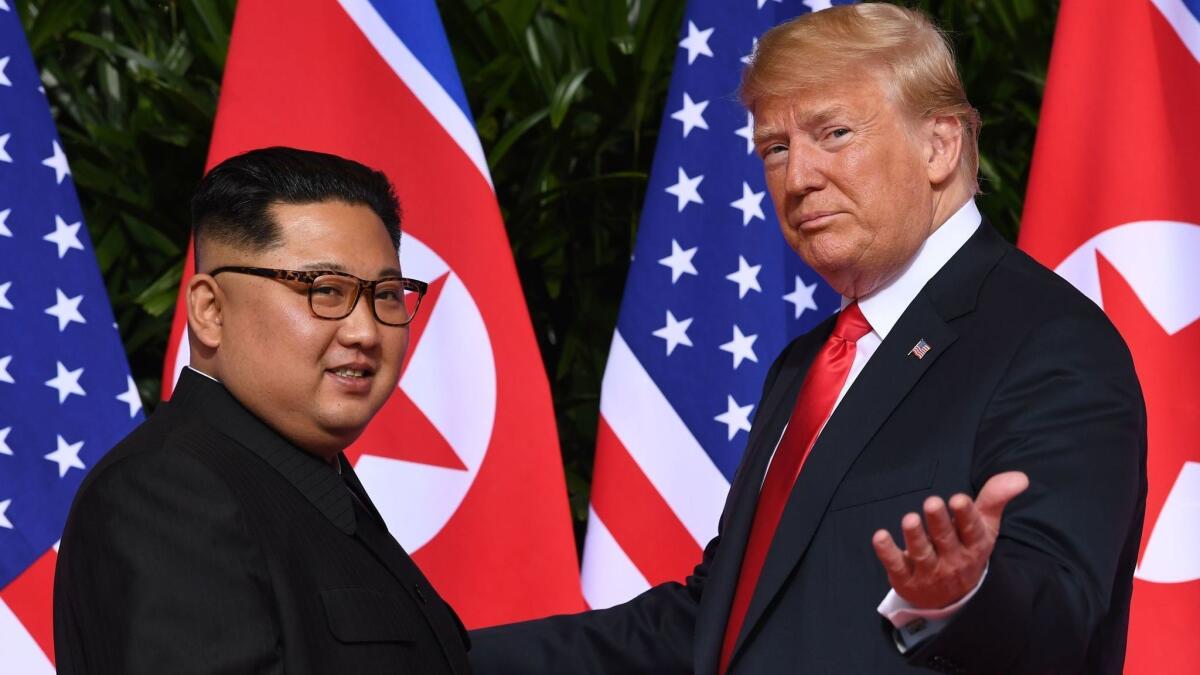Trump and North Korea’s Kim Jong Un to hold second summit

- Share via
Reporting from Washington — President Trump agreed to a second summit with North Korean leader Kim Jong Un in late February, despite the lack of significant progress so far toward the elusive goal of dismantling Pyongyang’s nuclear arsenal.
Trump accepted the date Friday afternoon after meeting Kim’s right-hand man and top spy chief, Kim Yong Chol, in the Oval Office for an hour and a half. As he did last year to arrange the first summit, the official traveled to Washington, hand-carrying a letter from his boss, to set the details personally with Trump.
“The president looks forward to meeting with Chairman Kim at a place to be announced at a later date,” White House Press Secretary Sarah Huckabee Sanders said. She confirmed the meeting would take place late next month.
Among possible venues is Vietnam, according to people familiar with preparations.
Trump had his first, historic meeting with Kim in June in Singapore, a meeting that yielded a vague denuclearization agreement but no concrete plans for dismantling North Korea’s arsenal. No additional outline of how talks would proceed was provided Friday.
Seven months after the first summit, the two sides still have not agreed on basics, such as the definition of denuclearization.
North Korea has refused to supply an inventory of its nuclear and missile arsenal, a step considered essential to any disarmament plan. Only a few meaningful talks have taken place between aides at the working level from the two sides.
Friday’s decision to go straight to a second summit, rather than complete any medium-range goals or preparation work, reflected what many outside analysts have seen as the flawed nature of Trump’s approach to talks, which focuses on high-profile show over the non-glamorous work of hashing out substantive details and agreements.
Current and former diplomats worry that in a second meeting with Kim, Trump again will put a priority on optics and not make progress on mundane but crucial steps involving inspections, monitoring, equipment storage and the like.
Trump has exchanged what he has called love letters with Kim and has repeatedly made exaggerated claims of progress.
The North Koreans, in turn, have not conducted any new nuclear tests since talks began, but have continued to produce missiles and improve their technology.
Kim has at times snubbed U.S. envoys, including Secretary of State Michael R. Pompeo, evidently preferring to deal directly with Trump. A planned meeting between Pompeo and Kim Yong Chol in New York last November was called off abruptly. U.S. officials said at the time that North Korea had canceled the session.
After their Singapore meeting, Trump stunned allies and his own advisors by announcing an end to joint U.S.-South Korean military exercises — a goal long sought by the North. He described the exercises as “war games,” using Pyongyang’s parlance.
One of Kim Jong Un’s goals is to obtain a formal end of the Korean War, which would in theory make a U.S. military presence on the peninsula obsolete — to the dismay of Seoul, Japan and other allies.
The North Koreans “believe they can outsmart him,” said Andrei Lankov, a professor at Seoul-based Kookmin University who has also lived and worked in North Korea. “They can shower him with flattery and manipulate him into giving concessions that they would never get from any other American president.”
Since Trump’s first exchange with Kim, several analysts have published reports detailing North Korea’s continued development of nuclear and missile technology. Pyongyang has demanded that the U.S. end its economic sanctions and guarantee the security of North Korea’s regime before it takes any steps beyond suspending nuclear and missile tests.
Vice President Mike Pence said Wednesday that the talks with North Korea were “promising,” but that the U.S. was still awaiting “concrete steps” by North Korea to “dismantle the nuclear weapons that threaten our people and our allies in the region.”
Trump has praised Pyongyang’s willingness to turn over remains of American service members who died in the Korean War and the release of three U.S. citizens who were detained in North Korean prisons.
He has studiously avoided criticizing Kim’s human rights record, considered among the worst in the world. Trump has also quietly turned a blind eye to China’s decision to break U.S. sanctions by allowing rice and fuel into North Korea.
Kim expressed frustration in an annual New Year’s address over the lack of progress in negotiations. But on a visit to Beijing last week, he said North Korea would pursue a second summit “to achieve results that will be welcomed by the international community,” according to China’s official New China News Agency.
Before Friday’s meeting in the Oval Office, Kim Yong Chol met with Pompeo at a Washington hotel. Pompeo, Kim and their delegations also shared lunch, the State Department said.
Separately, North Korean Deputy Foreign Minister Choe Son Hui attended talks in Stockholm, according to Swedish Foreign Ministry spokeswoman Diana Kudhaib, who declined to give further details.
Sweden’s TT News Agency said the talks included U.S. special envoy for North Korea Stephen Biegun and Swedish Foreign Minister Margot Wallstroem. Wallstroem was influential in securing the first Trump-Kim summit.
Sweden has had diplomatic relations with Pyongyang since 1973 and is one of only a few Western countries with an embassy there. It provides consular services for the United States. In March, Wallstroem held talks with her North Korean counterpart, Ri Yong Ho, in Stockholm, leading to the meeting between Trump and Kim in June in Singapore.
Times staff writer Barbara Demick in Washington contributed to this report.
More to Read
Get the L.A. Times Politics newsletter
Deeply reported insights into legislation, politics and policy from Sacramento, Washington and beyond. In your inbox twice per week.
You may occasionally receive promotional content from the Los Angeles Times.










